Dengie’s National Sales Manager, Laura Dolphin was once again chuffed to qualify for The Jockey Club RoR National Championship at Aintree.
“From the moment you arrive, stabling the horses on the prestigious yard with the names of former winners above the doors, walking past the winning post, riding a dressage test metre’s away from Becher’s Brook and looking at so many beautiful retrained Thoroughbreds happy in their new careers, it’s just amazing!” says Laura.
This was Laura’s second year at the championships where the event showcases these amazing horses and celebrates their new careers in either dressage, show jumping, eventing or showing.
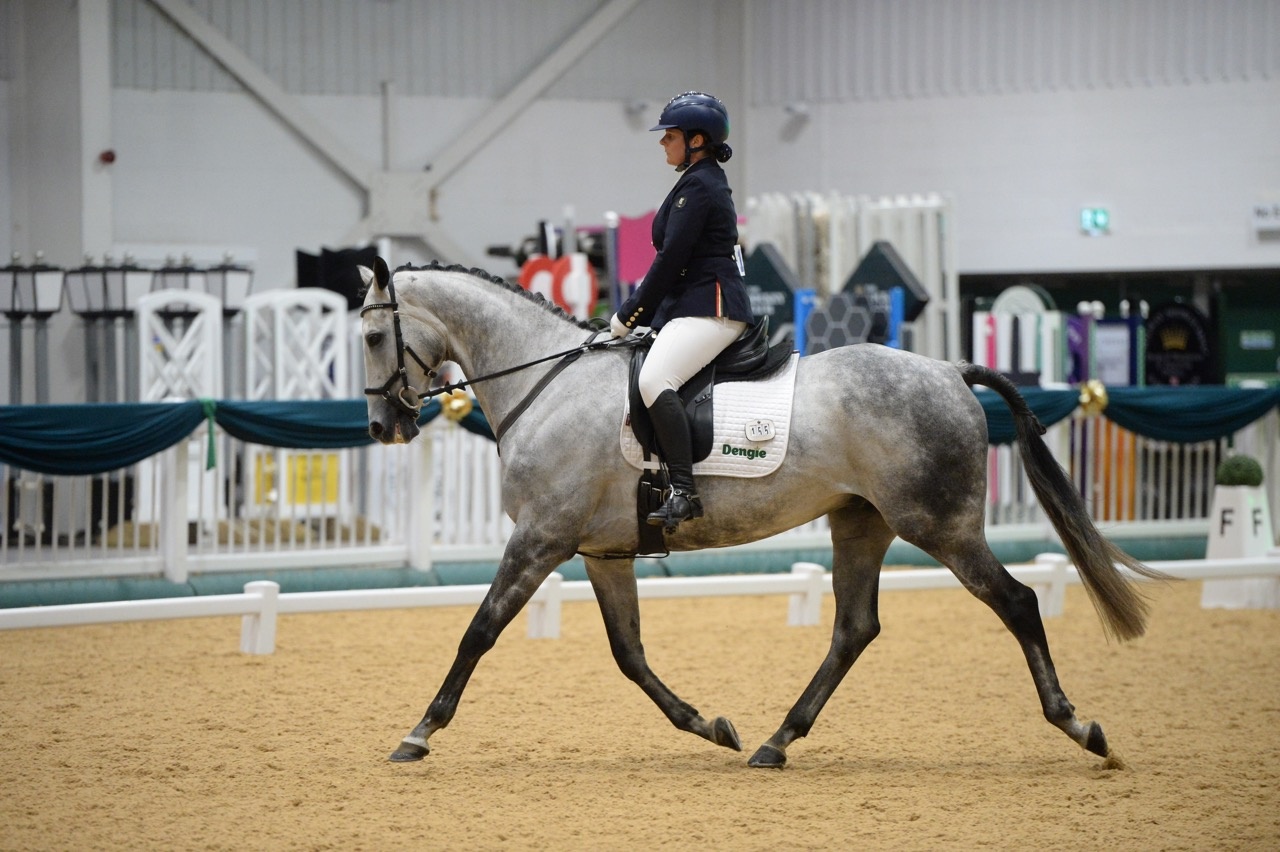
“Last year I watched the dressage freestyle to music and said to my Mum, ‘That’ll be Boris and me next year.’ We did it! I managed to qualify for the Novice Freestyle to Music; riding in the International Centre was the highlight, the music, lights and crowd created such an exciting atmosphere.”
Boris and Laura are trained by Dean Price, “Dean’s amazing he’s patient and understands retraining of racehorses, I’ve also tapped into Lou Robson’s retraining expertise by following her on social media and listening to her podcasts.”
Laura and Boris are new to dressage to music, performing to a floor plan by Jackson Black and music by the renowned Gaynor Colbourn. “I was very proud of Boris as it was the first time we had ridden to this music and floor plan at a competition! Lots was going on in the main arena, a very buzzy atmosphere but I held his hand and we did it!”
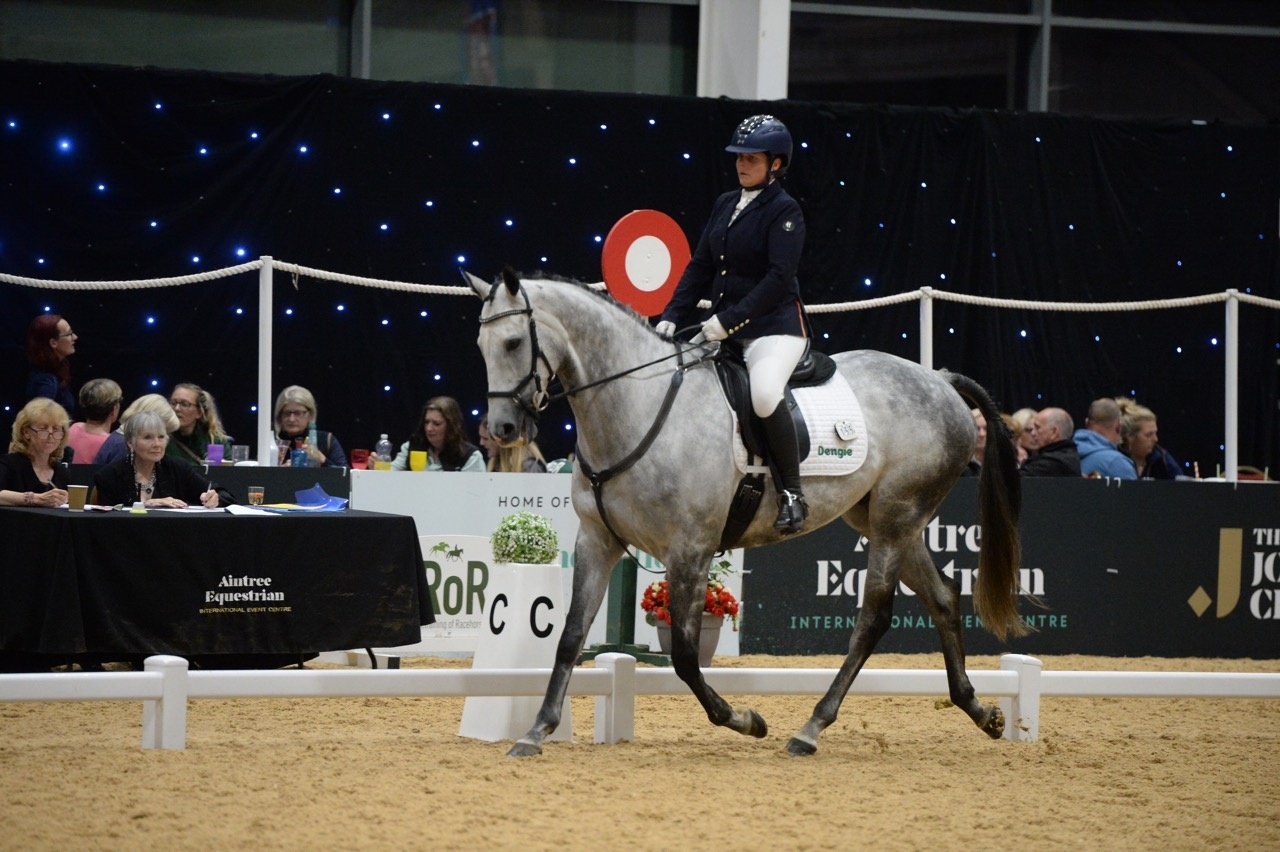
Boris is fed Dengie Cool, Condition & Shine alongside a balancer. He’s turned out during the day and in at night. “Cool, Condition & Shine is perfect for him. He was a bit of a fussy eater when I first got him three years ago and needed to gain some weight. I didn’t want to feed him anything that might encourage excitable behaviour so I opted for Cool, Condition & Shine, which he loves! He has two feeds a day plus hay and grazing; he’s now the perfect weight and has plenty of controllable energy.”
Have you ever wondered what it’s like to attend an equine nutrition conference?
At the beginning of July, I was lucky enough to be able to attend the European Workshop on Equine Nutrition (EWEN), which this year was held in the stunning Gamle Logen building in Oslo, Norway. EWEN takes place every two years and includes a wide range of presentations on various topics and the latest research surrounding equine nutrition.

When I arrived at the conference venue, I checked in and picked up my name tag and conference bag which contained a notepad, pen, info from the sponsors and a USB with the digital conference proceedings. We then quickly got started with a pre-conference meeting with researchers from several different universities as well as feed company nutritionists and industry representatives.
After the meeting, there was a welcome reception and the opportunity to view the conference posters for the first time. Conference posters are basically visual summaries of research projects, usually in A1 size, and include images, diagrams, graphs and tables alongside the text to illustrate the methods and results of the study. When someone applies to present their work at a conference, there is often the option to choose whether they would like to submit for an oral presentation or for a poster – the choice here will normally depend on the nature of the project. The posters are displayed throughout the conference, and there are opportunities to speak to the authors about their work during the breaks. This year at EWEN, the posters covered a wide variety of topics, ranging from a study into horse owners’ perceptions of ryegrass, through to research on different in vitro techniques of measuring feed digestibility. The welcome reception and poster viewing session also provided an opportunity to meet and catch up with friends and industry colleagues as well as getting to meet lots of new people too.
Day two opened bright and early with a fantastic keynote presentation from Janne Winther Christensen on the behavioural biology of horses with a focus on foraging. Janne highlighted the need to provide horses with a variety of forage types to improve welfare, since horses will naturally choose to forage on a wide range of different feed materials even when grass is in abundance. A variety of forage types can also provide enrichment and create a positive experience for the horse, which is so relevant when it comes to promoting good welfare. This was followed by shorter presentations on some of the latest research, as well as a further keynote from Shannon Pratt Phillips on a North American perspective on equine nutrition. It was fascinating to hear about how the horse feed industry differs in the United States and Canada compared to in the UK and Europe.
Following a delicious lunch and the afternoon’s presentations, the day concluded and we had a free evening in Oslo, during which I enjoyed meeting up with friends I’d not seen since the last EWEN and then going for dinner at the SALT street food venue on the waterfront with some other feed company nutritionists and suppliers. Despite what horse owners may think, many feed companies actually have very good relationships with one another, and it’s always lovely to catch up at these types of events!

Me at the Vigeland Sculpture Park – this is home to over 200 sculptures all by the same artist
Day three consisted of a morning of presentations, including a keynote from Manfred Coenen on the horse’s energy requirements, followed by a cultural tour around Oslo. My tour group enjoyed a coach trip out to the Vigeland Sculpture Park and up to the Holmenkollen ski jump, which hosted the Winter Olympics in 1952. The afternoon was followed by a delicious gala dinner in the evening at a local restaurant overlooking the harbour.
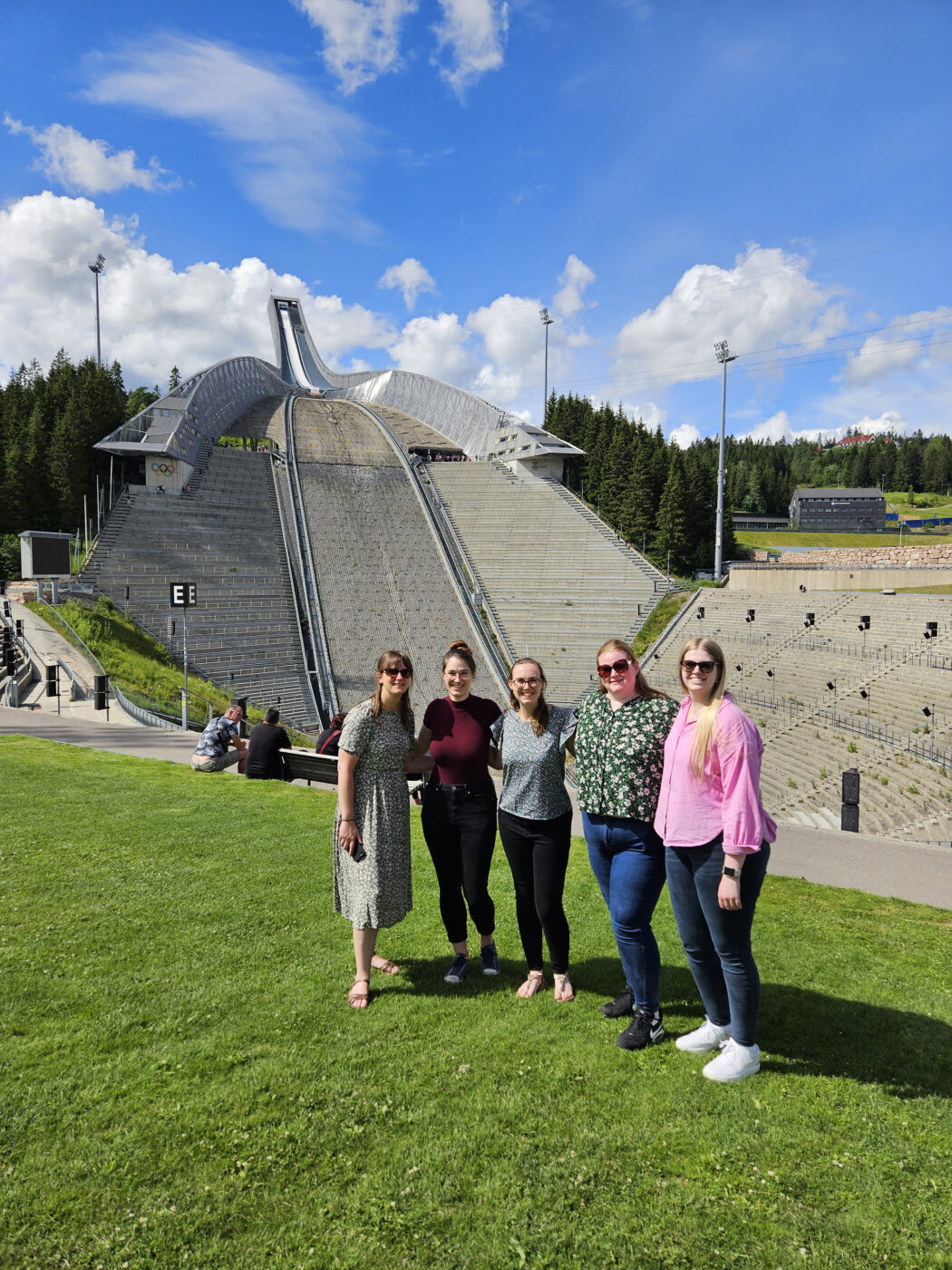
At the Holmenkollen ski jump – looking slightly unusual with no snow to be seen in the July sunshine!
The final day of the conference was held just out of town at the Norwegian University of Life Sciences (NMBU), about 30 minutes away on the coach. In the morning session, we enjoyed keynote presentations from Marcus Clauss and Michael Weishaupt, followed by some workshops in rotation in the afternoon. We were in smaller groups for the workshops, which allowed more time for discussion and questions. The first workshop I attended was on gastric ulcers and was hosted by Nanna Luthersson and Pat Harris. They discussed the current knowledge on gastric ulcers, including the benefits of alfalfa, and also reiterated the importance of getting a horse gastroscoped if ulcers are suspected. This allows for identification of the type of ulcers present (ESGD or EGGD), which will then guide treatment and management decisions. They finished up by talking about the BETA feed approval mark for horses prone to gastric ulcers. This is a scheme we have in the UK to help horse owners identify suitable products, but there is not yet an equivalent in other European countries.
The second workshop I attended was on forage and was led by Cecilia Müller who is an associate professor at the Swedish University of Agricultural Sciences (SLU) and has a wealth of knowledge on all things forage! She spoke about some of the research projects she is currently undertaking looking at forages and legumes, including some recently published work on different grass species and their digestibility and non-structural carbohydrate content. In the second half of the workshop, we went outside and had a tour round the forage plots at NMBU. These are rectangular plots of different types of legumes and grasses which are grown and harvested under relatively consistentconditions to allow for more representative comparisons. Despite the pouring rain, it was great to have the opportunity to go out and see the research facilities in person.

Some of the forage plots at NMBU
After getting the coach back to central Oslo, the conference officially drew to a close. I feel very privileged to have been able to attend EWEN again; it is always a fantastic experience and I always come away feeling very inspired! It’s so important that we keep up to date with the latest research and developments so that we can continue to provide the best advice we can to our customers.
I’d like to end this blog post with a big thank you to Rasmus Bovbjerg Jensen and the rest of the EWEN organising committee for once again putting on such a brilliant conference – we are looking forward to the 2026 meeting in Portugal!
In September 2017, Hannah and Matt Illston-Barsby offered Hope and Star a forever home with a view to them eventually become driving ponies. Seven years on and they are well on their way to a successful driving career.
After a successful indoor driving season gaining the Midlands Indoor Pairs Driving Champions, we are now in full swing on the outdoor season. This is our first competitive year so we needed to get two full events signed off so that we can compete nationally.
Due to wet ground conditions a lot of events have been cancelled so we started late but our first event was at Thoresby Park. We were thrilled with Hope and Star’s performance and completed the event safely and got their first event signed off. When we returned home our trainer Robert Buck from GB Pod Training group wanted to improve our dressage score. We made a plan that we needed to switch the ponies sides so we now have Hope on the left and Star on the right, this is due to Hope pulling away from the pole and not being completely settled in her work which was causing us costly marks in the dressage phase. We had to do a lot of long reining in preparation before changing them over, but the results have made such a difference and Hope no longer pulls away and is more settled in her work. We have also invested in a different carriage which is designed to cope with the different terrains you get and a bonus is that it is silver and green, so it goes well with our Dengie green marathon colours!
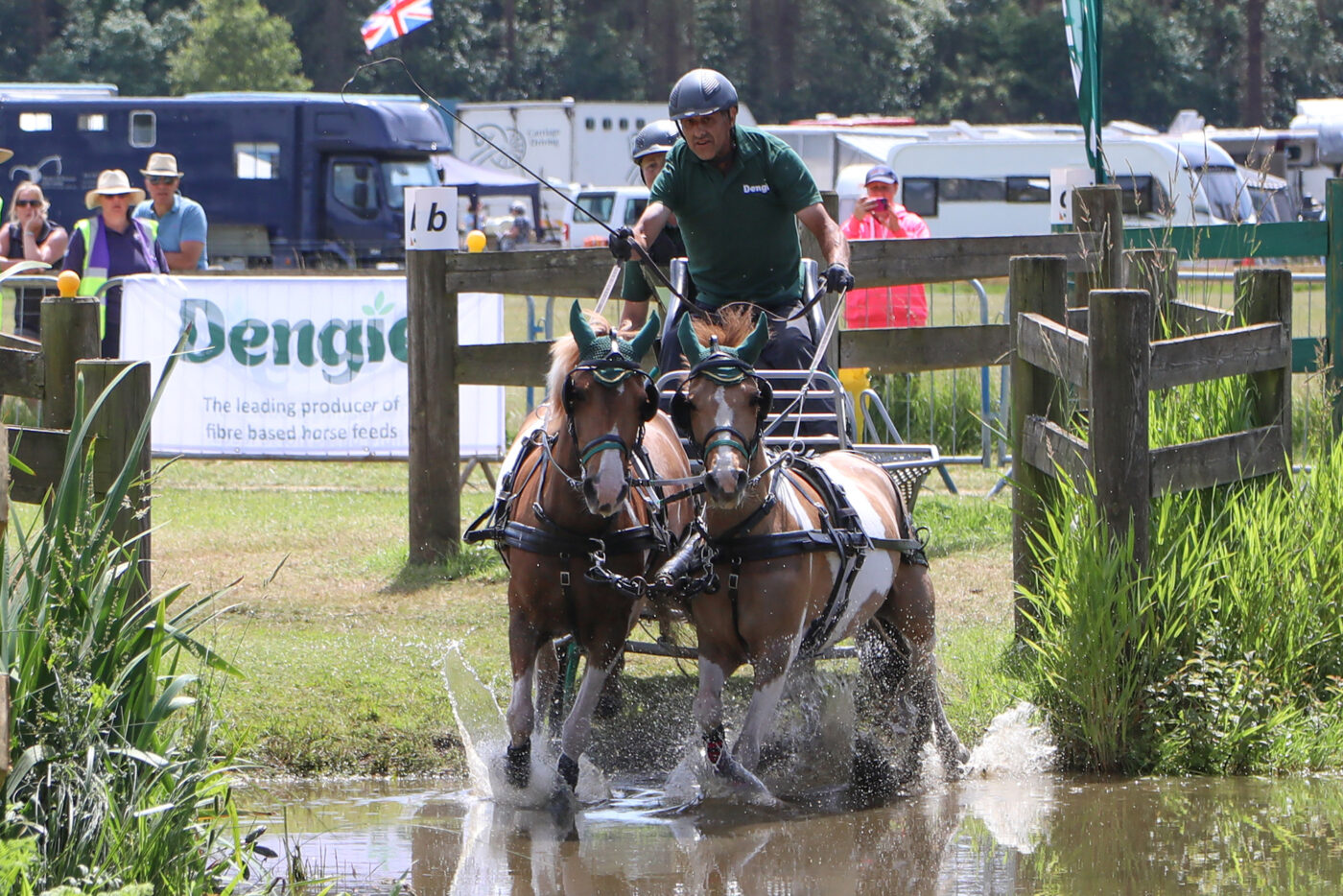
We felt ready for our next event Sandringham which has been a dream for both Matt and I to compete there, so we were very excited. We needed to stay focused on our aim, which was to just get round the event safely and complete, so we would get our last event signed off and receive our competency card to compete nationally. The first phase was dressage and all our hard work paid off as we improved our dressage score from our previous event by reducing 13 penalty points and were lying 5th overnight in our class; we were thrilled! Next day was Marathon Day and this was a huge ask as it was a big event, but we managed to keep it together and complete with no penalties and kept our 5th position! The last day was a Cones course and another very impressive set up with a JCB arch to drive under. We had a fabulous drive just two cones knocked and a few time penalties, but everyone struggled to keep within time, and we finished in 5th position and our card signed off so we can now compete nationally!
We are absolutely over the moon with how we are starting our journey into carriage driving and we are so lucky to have the fantastic support from Dengie Performance Horse Nutritionist, Claire Akers to make sure Hope and Star are kept in their best condition. They are looking fabulous on Dengie Performance Fibre!
Well June and July are best described as ‘conference season’ which kicked off with the BETA annual Feed Industry conference. Sustainability and equine welfare have been key topics discussed at all the conferences but it was really interesting to see how the relationship between them was brought into focus at the Thoroughbred Breeders Association conference. Studies funded by Dengie, amongst others, have demonstrated the relationship between diet and behaviour in recent times and it was brilliant to at last hear this being discussed.

Respected vet and behaviour expert Dr Gemma Pearson detailed how what is fed right from conception, through development and then on the track, impacts on the behaviour and welfare of the racehorse. The public perception of racehorse welfare is key to the sport’s future and the horse’s diet is fundamental to their health and behaviour. The studies from Lab to Field that we have been sharing in our webinars and on the Horse & Hound podcast demonstrate that feeding fibre is not a barrier to performance either! Let’s hope the TBA conference is the start of some really big shifts in attitudes to feeding racehorses.

The last of the recent conferences was the International Colic Conference which was held in Edinburgh. The conference is only held every three years and only comes to the UK every so often – I can (just about) remember attending the last time it was held on these shores in 2002! I was really excited to hear more about the INCISE project which is the initiative to gather data about colic surgery and report on the most common issues, levels of successful outcomes etc. As this was a key part of my own PhD, it was brilliant to see so much data being presented and shared. Without being able to compare and benchmark outcomes, there is little chance of standards being raised across hospitals.
A particularly interesting paper explored the number of horses returning to work after colic surgery. This was carried out in the USA and showed that the more serious the colic (volvulus or the intestine twisting and strangulating itself for example) the less likely the horse was to return to the same level of work. However, this wasn’t just because surgery was less likely to be successful, it also came down to what were defined as non-biological factors. These included the fact that if owners had perceived their horse to have had a tougher time, they were less likely to push them as hard if they returned to work. This is both interesting in terms of the importance of clarity when reporting successful outcomes – the success of the surgery wasn’t the determining factor in these cases – but also reaffirms that, as horse owners, in most cases we just want a happy healthy horse after surgery!
And finally, something that became very apparent throughout the conference and became a bit of a running joke, was the level of funding that those based in the USA and to some extent Europe, have in contrast to those based in the UK. As presenter after presenter from the UK made their ‘no declaration of funding’ statements, a ripple of giggles went through the audience. Definitely a case of ‘funny, not funny!’
30yrs ago Tina Canton received a call up for the GB young rider eventing team, sadly it turned out it wasn’t meant to be as she had a bad fall a couple of weeks before Bramham so sadly never made it onto the team. After years of experience and a change of discipline Tina finally got that Team GB call up!
I was honoured to be asked to ride at the Veteran Show Jumping Championships in Italy with my own gelding, Bannagh Romeo aka George, whom I’ve owned since an unbroken 3-year-old, so it’s very special he was chosen and goes to show you should never give up on your dreams!
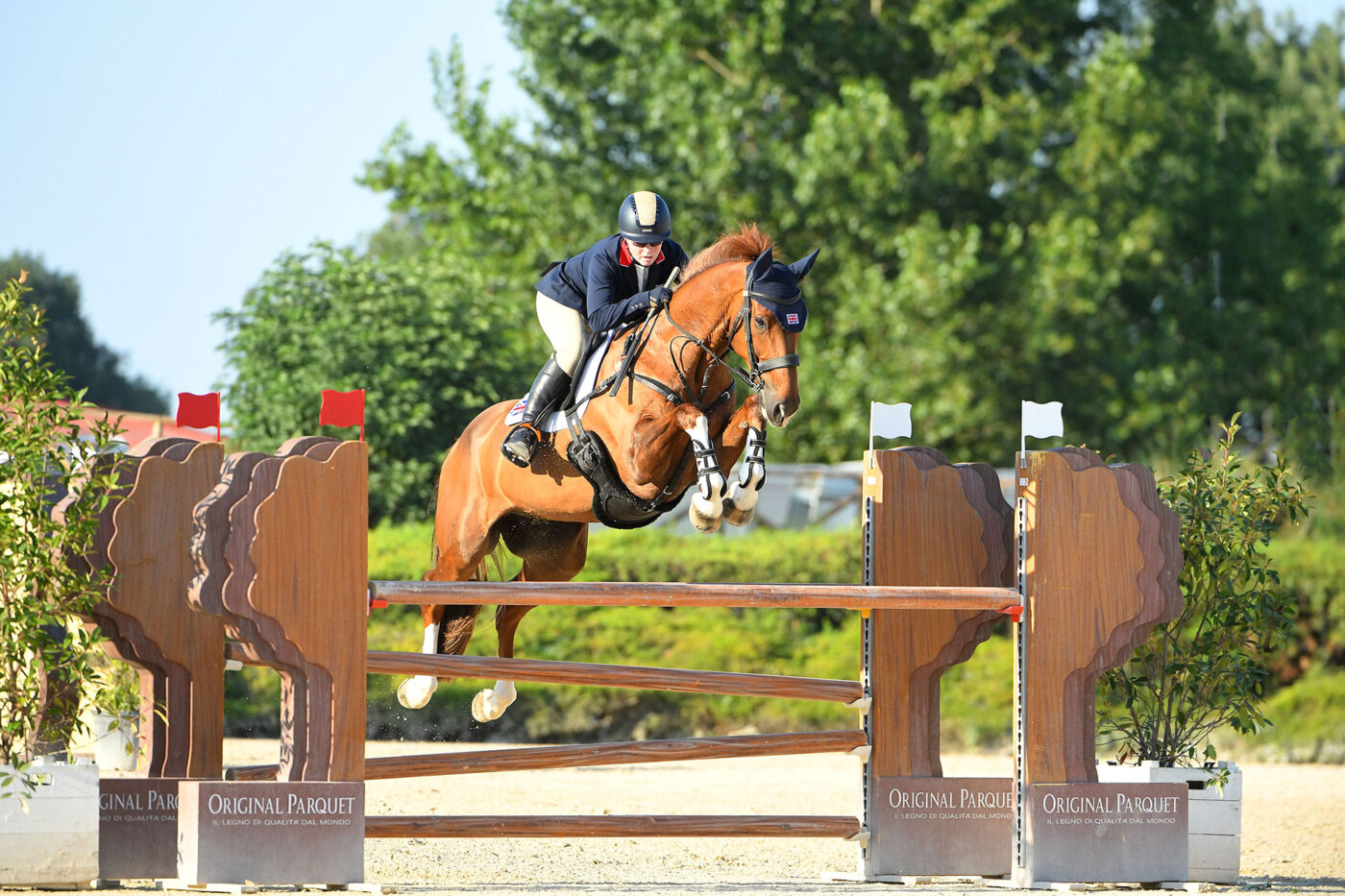
I only got the call up about 10 days before we had to leave – so it was a bit of a mad panic to organise everything. A team zoom call allowed us all to meet one another, helped us make some decisions and get organised; we volunteered to take our lorry Bertha and take another rider with us. We then compiled the packing list, paperwork and vet tests for travelling. I’ve travelled abroad as a coach and helped organise horses being shipped, but this was the first time taking one of my own.
The day finally came to ‘set sail’ and we met up with two of our team members in Dover to catch the early ferry to Calais. Despite our paperwork being correct and completed by a very experienced vet it was refused by customs! Thanks to our vet who drove down to Dover with copies of the paperwork and after discussions with customs they finally accepted our papers, and we could travel – a very stressful start to our long journey.
With the customs situation behind us we headed onto Dijon, then on to Nice catching up with the rest of the team and a final 11 hours of driving to get the event venue, Horse Riviera Resort, Rimini, Italy. Wow! What an amazing facility, fantastic stables, everything you could possibly need for horse and rider! We got the horses sorted so they could rest and we set-up camp.
The next day started hot! Lots of in-hand walking and a good stretchy school in the cooler morning and evening allowed everyone to relax and recuperate after the mammoth journey.
Wednesday was the official trot-up and all the horses passed, then we went on to do an arena familiarisation; we all had 90 seconds to jump a simple course of nine fences up to height, which resulted in all the horses jumping well.
Thursday was the first competition – a speed class with three of us being in the prize giving, standing us in bronze position going into the next day.
Friday was the team competition run like a Nations Cup – two rounds and then a jump off in the event of a tie. It was quite a challenging day, so warm, more a day for the beach or pool, not jumping two rounds of show jumping in a jacket, boots and hat! The horses all coped amazingly well and jumped superbly; we finished in silver position! It was very special to receive that medal and rosette! A team celebration dinner at a local restaurant finished off the day.
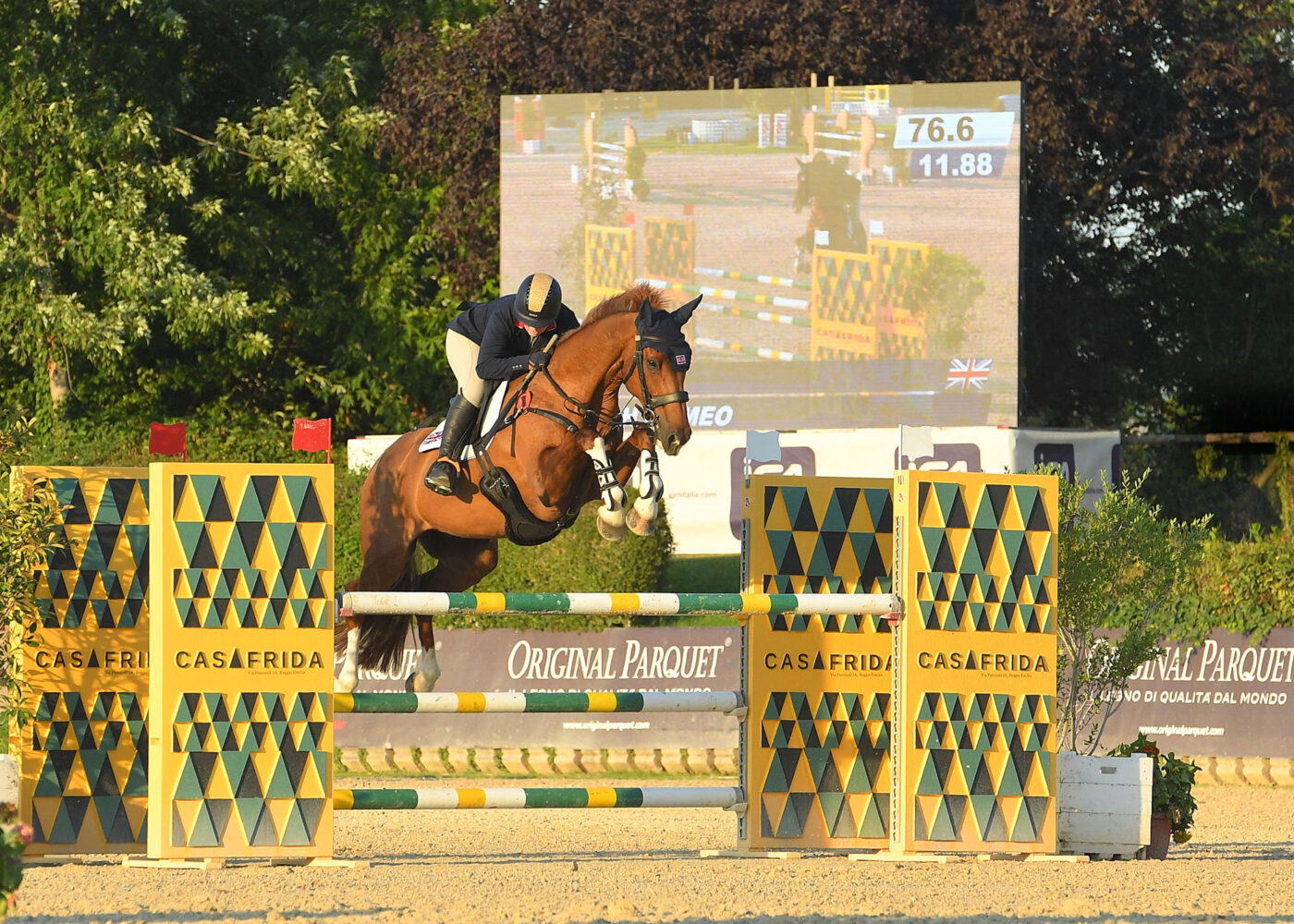
Saturday was a rest day for horses and humans! Sunday was the individual competition where everything you jumped counted towards the score – so it was all to play for. Uncharacteristically George had a couple of fences down, I think the heat was taking its toll and we dropped to finish 16th which was a little disappointing.
On Sunday we packed up the lorries to head home via Nice, on the high of winning a medal only for this euphoria to be dampened the next day when we had a braking fault on the lorry. So, we transferred the horses to the other lorry, limped to a garage and managed to get it repaired. All fixed we finally hit the road with George & Co back on board, heading to Lyon and then Calais we finally got home at lunchtime on Thursday!
 It was a fabulous trip with memories and new friends made. To be on Team GB with George made me very proud, he jumped brilliantly, coped well with the heat and the epic journey. Dengie Alfa-A Original was the foundation of his diet throughout, feeding him a small amount prior to riding, as well as within his main feeds, helping to keep him fuelled and hydrated.
It was a fabulous trip with memories and new friends made. To be on Team GB with George made me very proud, he jumped brilliantly, coped well with the heat and the epic journey. Dengie Alfa-A Original was the foundation of his diet throughout, feeding him a small amount prior to riding, as well as within his main feeds, helping to keep him fuelled and hydrated.
To say the past few weeks have been a mix of winning moments and washouts would be an understatement. We’re certainly a team who’ve been affected by the unseasonably wet weather and the abandoned events. With the horses all feeling on top form it was so disappointing to withdraw from Catton after show jumping, especially when they were all on such good dressage scores, but we picked ourselves up and headed to Farley, where the sun came out and we won!
It was a hugely exciting win for Monbeg Pompeii (or Foxy to her friends) who’s owned by our very good friend Rosie Williams. We were absolutely thrilled that Foxy finished with a sub-thirty dressage, two very good jumping rounds and just a few speeding points – oops!
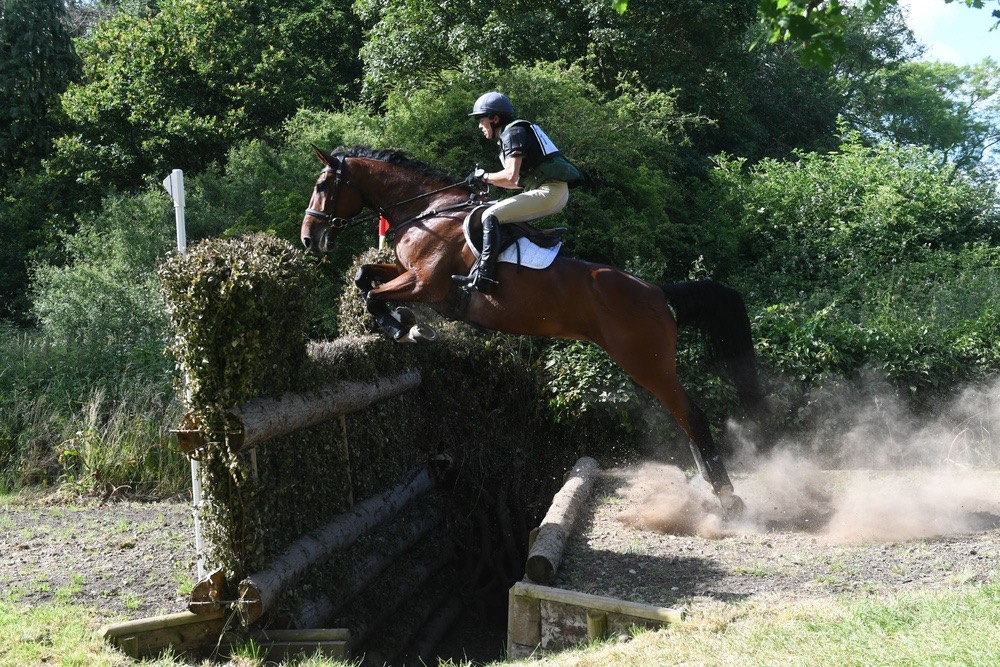
Foxy’s confidence has improved so much across the country in the last few months, and she flew round an influential track like an absolute pro. I’ve been riding her while Rosie is at university but I would quite like to steal her permanently! We’ve looked at each of the different areas of her work and care to identify where we can make small improvements. One thing we noticed was that her dressage saddle wasn’t quite right, so we made an emergency call to our super saddler Helen Leedham and Albion Saddles. They worked some magic with a new dressage saddle that seems to have made a huge difference. Foxy was noticeably more comfortable and was able to deliver a more relaxed and overall brilliant test.
Then came Offchurch, again in the dry which was a nice change, and again some super results, with a 3rd in the BE105 for Stan! Despite deciding he couldn’t remember how to go backwards in a dressage test we ended up second after the first phase! He went on to jump two super rounds for 3rd place, which we were absolutely thrilled with!
One area I can always be confident of is that the horses are on the very best nutritional plan, thanks to the support of the Dengie Nutrition team, in particular Claire Akers and Hannah Turner. Both Foxy and Stan have very good temperaments and hold their weight well, however, they wouldn’t be excessively good doers. Together with Dengie we’ve found that Dengie Hi-Fi Senior suits them both incredibly well. The straw-free formulation makes it ideal for performance horses and not just seniors, and that certainly seems the case with these horses. The addition of rapeseed oil in Hi-Fi Senior gives them a fantastic shiny and healthy coat too. Foxy’s speeding ticket certainly goes to prove there is no need to overcomplicate things with heating feeds, just a good base diet that suits the horse is all we need!
Sarah-Jane Brown has always dreamt of competing at Bolesworth International and this year with Fliss going so well, it seemed like a good time to give it a go!
The Cheshire event is a 6-hour drive from Cornwall but with two weeks of competition on offer it seemed a good time for a ‘holiday’.
It was my first show jumping international and we were lucky enough to have some top riders at the show, to warm up in the same ring as John Whitaker, Scott Brash, William Funnel et al. was both daunting and educational. Mind you I did nearly run Geoff Billington over on one occasion as he put up jumps for a pupil.
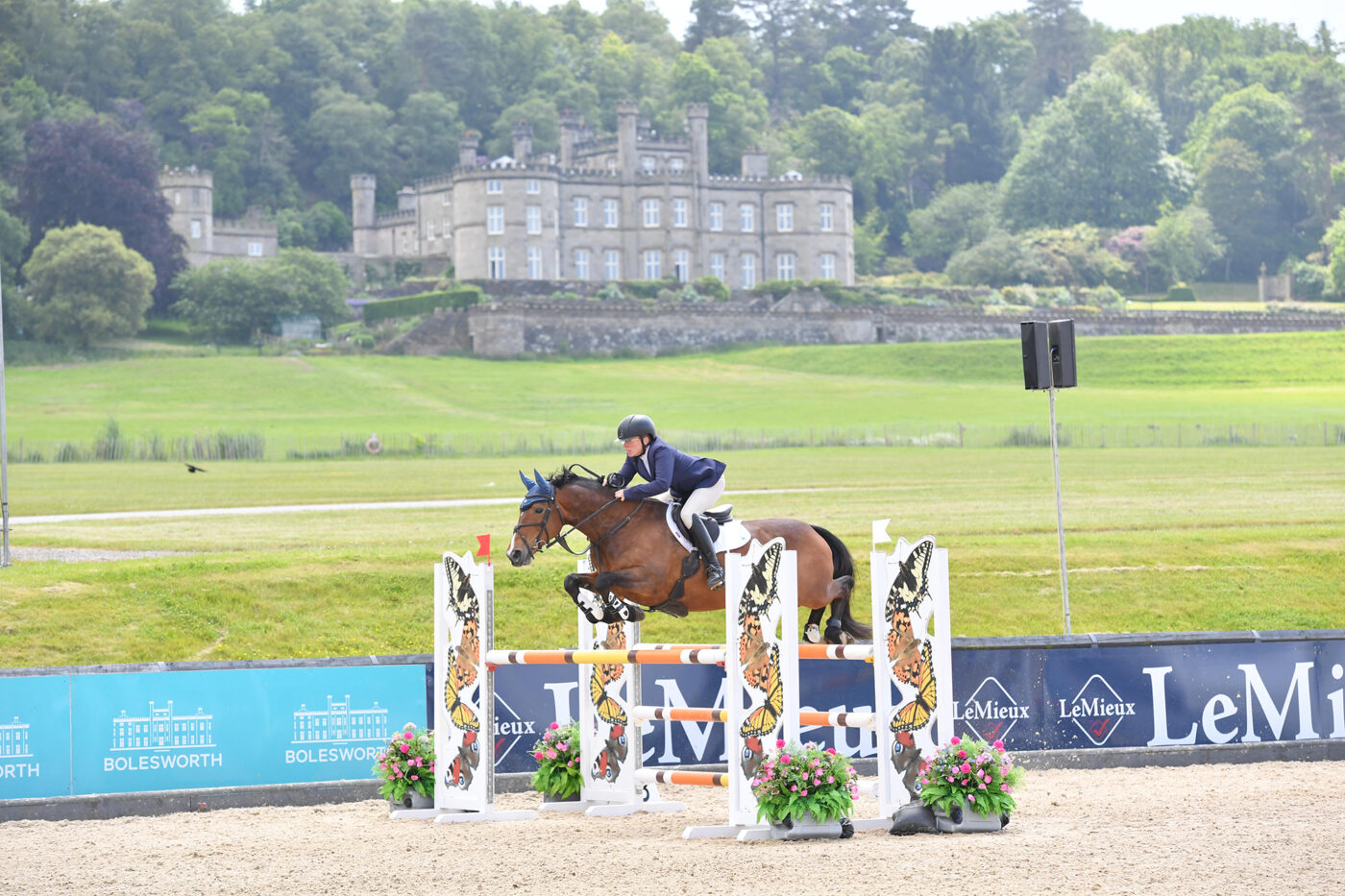
I for one suffer a bit of imposter syndrome and wondered if I should be at these events. We were competing at the lower 1* level with classes 1.25-1.35. I shouldn’t have worried Fliss excelled, she knew she was at a special event with a big atmosphere. She loved the people, the large ring and the courses. We jumped three classes each week, the first week we were 7th in the 1.25 speed, 11th in the 1.25 two phase and 13th in the 1.30 Grand Prix, many of these classes had 80 plus entries.
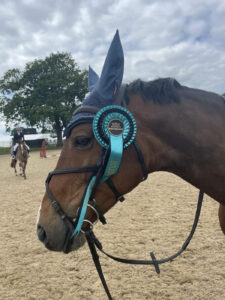
The second week we consolidated our form and had a 6th place in the first 1.25. This meant a lot as we were able to go in for a prize giving and receive a rosette, we were then 7th the next day and on the last day we jumped a super round in the 1.30 Grand Prix only for me to have a pole at one of the easier fences which I could (and did) kick myself about. However, five out of six classes placed was far better than I hoped.
The whole experience was eye opening, it was great to watch the pro-riders and the big grand prix classes as well as the fun classes such as the ride and drive. I walked the course for the Eventers Grand Prix and would have loved a crack at that. Nice to be able to walk around the estate and the dogs were certainly on red alert when they saw the resident hares!
Despite two weeks away from home Fliss maintained great energy levels and looked fantastic on Dengie Alfa-A Lite, as she can do rather well at this time of year!

It’s the time of year when, as a nutritionist, I spend proportionally more time speaking about laminitis either giving advice via the Dengie Feedline or during talks at client evenings.
For horses that have restricted grazing, the reliance on conserved forages increases and one of the common questions we have is “how do I know if my forage is suitable for my laminitis prone horse?”. In addition to this, there are some perpetual myths regarding the suitability of certain forages for laminitis-prone individuals that cause concern. One of the most common is that last year’s hay is safer than this year’s hay which isn’t always the case. My answer to these queries is always the same – if you can, get your forage tested.

What affects the nutritional quality and suitability of forage?
Environmental conditions during growth and at the time of harvest, the type of grass and the age of the plant at the time of harvest all have an impact on the nutritional profile of forage. You can’t tell by looking at a forage what it will supply, particularly in relation to its sugar content, and so testing is helpful. For those concerned about laminitis-prone individuals, levels of non-structural carbohydrate (NSC) in a forage are a key factor to consider. This is an analytical term and is the sum of water-soluble carbohydrates (WSC) and starch added together. Water-soluble carbohydrates are simple sugars plus fructan which is the storage carbohydrate for grass. The current consensus is that less than 10-12% NSC on a dry matter basis should be aimed for, but for some individuals this may still need to be lower. In addition to the NSC content the amount of Digestible Energy (DE) in the forage is also of concern as keeping horses at a healthy weight is half of the battle when it comes to managing laminitis risk.
For many years now Dengie have offered a forage analysis service where we send forage to an external laboratory for testing and translate the results into practical information and advice for horse owners. Recently I re-named the different tests so it’s much easier to identify which ones to carry out to determine if a forage is suitable for a laminitis-prone individual. As harvest is in full swing it seemed like the ideal time to review the results from the last 12 months.
Types of forage tested
Historically we have always tested a greater number of hay samples than other types of forage. Increasingly though, we are testing more forage that we would describe as wrapped hay rather than haylage. Of the wrapped forage samples that have been submitted in recent years, only around 20% of them have been true haylages by which we mean fermentation has taken place. We are now defining the rest as wrapped hay as they have a dry matter greater than 65% and so little or no fermentation has taken place. This means that nutritionally they are more like hay than haylage even though they are wrapped in plastic.

Digestible Energy
The forages tested supplied very similar levels of DE with an average of 9.8MJ/kg and ranging from lows of 9.1MJ to highs of 10.5MJ. A 500kg horse consuming hay to appetite, which would be approximately 12.5kg dry matter, would consume 122.5MJ based on the average. A 500kg horse at rest only requires around 70MJ DE to maintain weight and so it’s no wonder that ad-lib hay is likely to result in weight gain based on these results.
Water-Soluble Carbohydrate
The percentage of water-soluble carbohydrates on a dry matter basis for the forage samples tested can be seen in the graph below. The tests were conducted using wet chemistry techniques. In a true haylage where some fermentation occurs, the level of water-soluble carbohydrate can be lower than hay as it is the sugar that is fermented to create volatile fatty acids (VFAs). However, a lower sugar content needs to be considered along with other key factors such as the energy level in the forage and rate of intake to determine suitability for good doers. As little or no fermentation occurs with wrapped hay, the WSC levels are typically like hay.
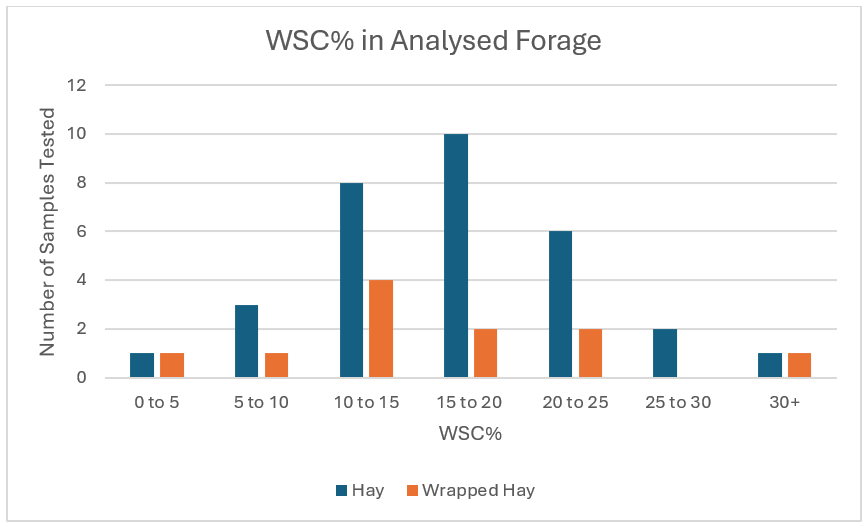
Of the forages tested for starch the maximum value we saw was 2.3% which is typical of the 2-3% averages. It is interesting to note that if we calculate the NSC values for these forages (the sum of WSC and starch) only 14.3% of the samples tested last year would meet the target of 10-12% NSC which is advocated for laminitis-prone individuals.
Putting this in to practice
If you have a good do-er and your forage falls into the 85.7% of less desirable NSC results or it is not practical to test your forage as you don’t have a consistent supply, what steps can you take?
Other than switching to an alternative forage source, soaking is one option to reduce the NSC content of your forage. There are disadvantages to soaking hay, not least from the amount of water used and its effect on the environment, but it also results in a very heavy net for us to lift and is more difficult to put into practice in the winter during freezing conditions. Another more sustainable option is to consider mixing straw through the forage ration to lower the overall NSC intake whilst also significantly reducing the DE intake as well. We discuss all of these issues and more in our Weight Management and Laminitis Guide.

A final thought
Forage analysis is only one part of the picture. Whilst 10-12% NSC is given as a guide, it is just that. Some laminitis prone individuals may be managed well on forages that are potentially higher NSC than this whilst for others this may still be too high – there is a lot of individual variability in relation to metabolic issues. If you are the owner of a laminitis-prone individual, our advice would be to work with your vet to monitor your horse’s insulinaemic response to feed. These results will help to demonstrate your horse’s risk of laminitis and inform their dietary management too.
For more information on what to feed your horse or pony or for help and advice on all aspects of feeding call the Dengie Feedline: 01621 841188 or complete our Feed Advice Form.
In her spare time, Dengie Feed Advisor Katie Evans enjoys riding side-saddle in a wide range of disciplines including dressage, showing and jumping. In her latest blog, she updates us on how her showing season has gone so far.
May is always a busy month with shows, but this year seemed to be particularly full on! We started the month off with Royal Windsor Horse Show on the first weekend in May, a week earlier than normal meaning one less week of prep! Unfortunately, the weather was not on our side and by the Sunday when we were competing, the lorry park looked more like a ploughed field than a showground. The walkways, warmups and grass rings had also gotten pretty churned up. The Windsor team were brilliantly organised with a team of tractors to tow everyone on and off, as well as putting straw down on all the walkways and rolling the rings. I have to say, I did feel very grateful to at least not be riding a grey!!
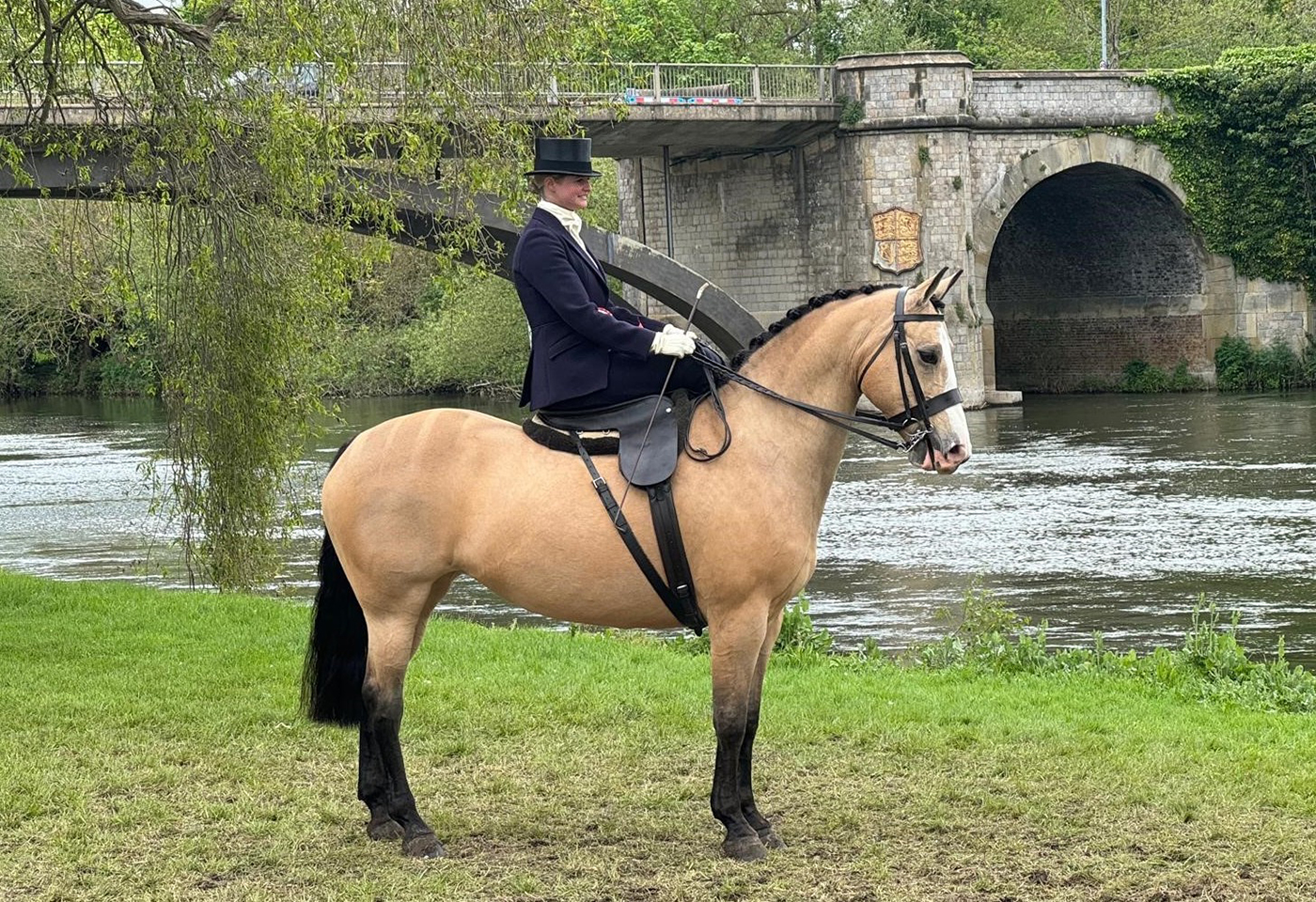
Next up was Hadleigh Show who had side saddle classes for the first time this year. This is the first time we have been to Hadleigh which had a brilliant atmosphere and a lot going on for a one-day show! Pearl was quite disappointed that the Working Hunter fences had been left up from the class before and she wasn’t allowed to jump them, but I was very pleased with how she went to come second in both her classes.
The following weekend we had an early start for Hertfordshire County Show with the side saddle classes being in the ring for 9am. Again, to Pearl’s disappointment we warmed up next to the show jumping but didn’t get to jump round, but she felt absolutely fantastic in the ring to win the Best Horse or Pony Ridden Side Saddle class and second in the Ladies Show Horse class, just missing out on our London International Horse Show ticket. She then stood Reserve Side Saddle Champion which I was thrilled with. Herts is always such a lovely show with so much to do and see but unfortunately, we didn’t have time to look around this year as we had to shoot straight off to get to my friend’s wedding, which I thankfully made just in time!
We finished the month off with two days at the Suffolk Show and as we stayed for the duration, we had plenty of time to look round, shop and watch some other classes. On the Wednesday, Pearl won the Side Saddle Concours d’Élégance class and on Thursday she was pleased to finally get to jump in the Working Show Horse class. She jumped a fantastic clear which I was thrilled with, to come second, again narrowly missing another London International ticket!
June is not quite so busy, we have one show planned, our side saddle area show, and a couple of dressage outings which we will also do side saddle as we are hoping to qualify for the British Dressage Associated Championships again this year. We also have a couple more London International qualifiers planned for July at Kent County and Tendring, as well as our Side Saddle National Show at the end of the month.
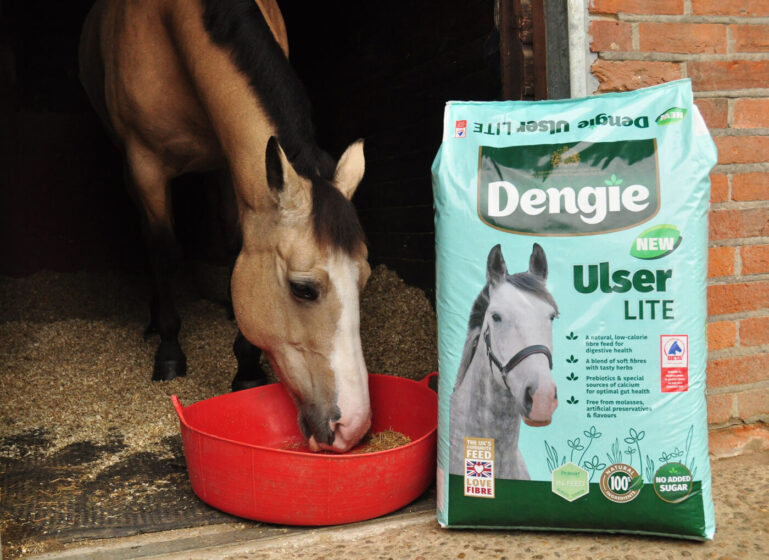
Pearl is fed Dengie Ulser Lite with a performance balancer to provide her with a balanced diet which is high in fibre but low in calories, sugar and starch. She is a good doer but this diet provides her with plenty of slow-release energy and stamina for her busy workload, without promoting weight gain. Pearl also has a small amount of Dengie Alfa-Beet with plenty of water to help keep her hydrated, she has this and salt in her ration every day, but an electrolyte supplement is added on her harder working days. I keep the Alfa-Beet in her ration every day, to ensure no sudden changes are made to her diet by only adding it in on show days which could cause digestive disturbances.
A big thank you as always to my mum who is top driver and groom and gives up her free time to come to shows with me!
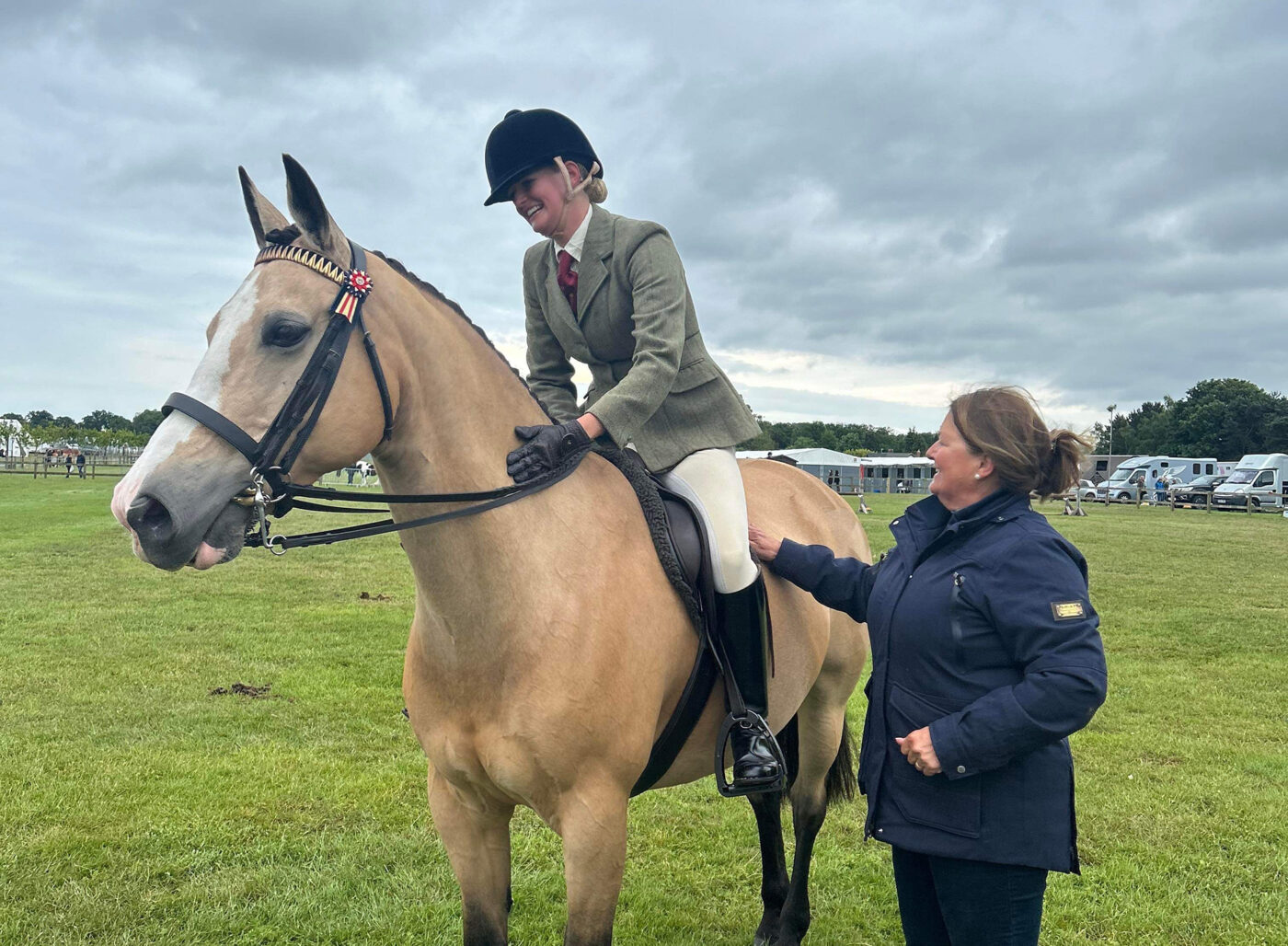
It is now widely accepted that equine obesity is a major welfare concern in the UK. In 2023, 56% of the horses we saw at weighbridge and feed advice clinics were overweight, which reflects levels of obesity regularly cited in the literature. Owners of overweight horses and ponies are often keen for advice on the best ways to manage their horses’ weight whilst still ensuring their welfare and nutritional needs are being met.
In situations when these horses need to be stabled or turned out on ‘no-grass’ areas to limit their calorie intake, it can sometimes become a challenge to keep them entertained without being able to supply ad lib forage. Providing diversity for the stabled horse has become popular in the form of a hedgerow hay net, where hedgerow plants are mixed with or fed alongside the normal forage ration. From conversations with horse owners, it’s become clear that many are feeding these plants, sometimes at high levels, assuming that they offer no calorie or sugar contribution to the diet when that’s simply not the case.
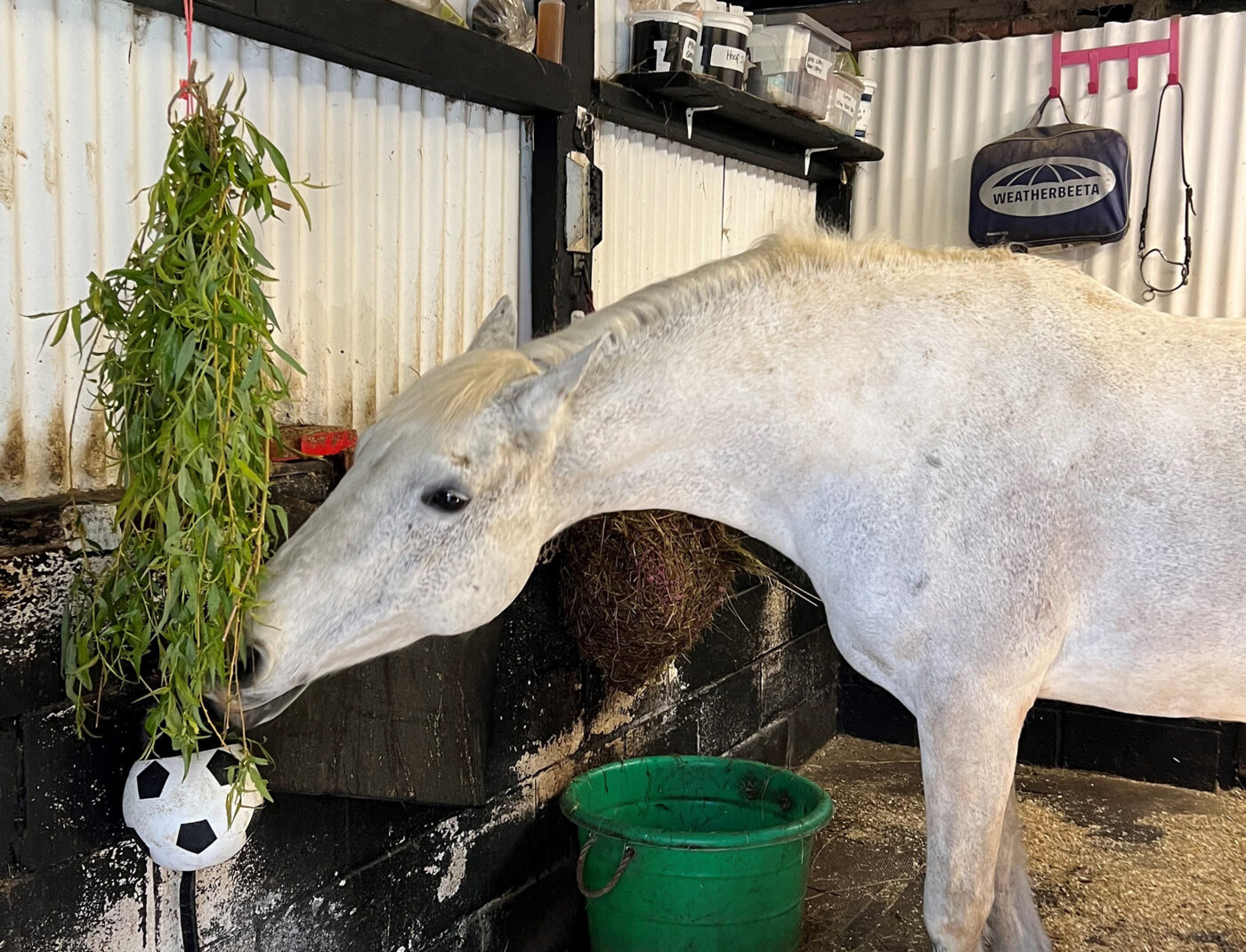
To help put these figures into perspective for horse owners, we have recently been reviewing analyses results for various hedgerow plants and weeds which we’ve previously sent to the lab for testing. The table below shows how much 1kg of each of these plants will provide of various nutrients per day. We can see that the levels really vary between different plants. Of particular note is the fact that the DE (digestible energy, or calorie content) and WSC (water soluble carbohydrates including the sugar and fructan) contents of poplar are very similar to levels found in an average hay. Whilst the other plants contain lower levels of DE and WSC, they definitely still cannot be classed as being calorie or sugar free. It’s important to remember though that these results should just be considered as a guide, as they only represent a snapshot in time and levels may vary depending on lots of different factors.
How much does 1kg of different hedgerow plants provide?
| Nutrient* | Sticky Weed | Cow Parsley | Hazel | Hawthorn | Willow | Ash | Poplar | Average Hay |
|---|---|---|---|---|---|---|---|---|
| Digestible Energy (DE) (MJ) | 1.47 | 2 | 2.31 | 3.79 | 3.95 | 4.99 | 8.15 | 6.5 - 10 |
| Dry Matter (g) | 135 | 186 | 216 | 332 | 380 | 451 | 828 | 840 - 920 |
| Crude Protein (g) | 15 | 28 | 49 | 38 | 52 | 56 | 115 | 40 - 130 |
| Oil (g) | 5 | 8 | 8 | 14 | 16 | 24 | 38 | 8 - 28 |
| NDF (g) | 43 | 75 | 75 | 133 | 182 | 178 | 434 | 420 - 600 |
| ADF (g) | 42 | 55 | 49 | 107 | 147 | 146 | 266 | 250 - 370 |
| Starch (g) | 16 | 13 | 17 | 35 | 14 | 21 | 4 - 28 | |
| WSC (g) | 28 | 25 | 10 | 14 | 26 | 28 | 72 | 75 - 100 |
*Analysis reported on an as fed basis
More information on hedgerow hay nets can be found here, but these are some key things to remember if you’re thinking of incorporating any of these plants for your horse or pony:
- Hedgerow plants can be good for adding variety to your horse’s diet but should not be considered calorie-free.
- Make sure you are not feeding anything which is toxic to horses. The British Horse Society and RSPCA have useful guidelines on their websites to help with identification of poisonous plants.
- Feed in small amounts (e.g., a couple of handfuls or 500g maximum of each plant type) and introduce new feed materials gradually.
- If your horse is overweight, consider whether using straw to replace a portion of their hay or haylage ration may be a better choice to slow down their eating time and keep them busy for longer. More information on feeding straw can be found here.
- If you or anyone on your yard competes under rules, bear in mind that picking weeds and herbs or other plants for your horse could increase the risk of NOPS contamination and is best avoided. Click here for further information about prohibited substances.
For more information on what to feed your horse or pony or for help and advice on all aspects of feeding call the Dengie Feedline: 01621 841188 or complete our Feed Advice Form.

